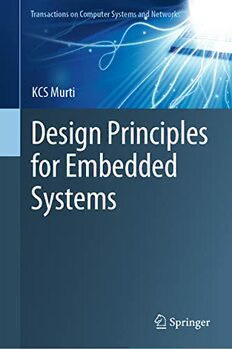Table Of ContentTransactions on Computer Systems and Networks
KCS Murti
Design Principles
for Embedded
Systems
Transactions on Computer Systems
and Networks
SeriesEditor
AmlanChakrabarti,DirectorandProfessor,A.K.ChoudhurySchoolofInformation
Tech,Kolkota,WestBengal,India
Transactions on Computer Systems and Networks is a unique series that aims
to capture advances in evolution of computer hardware and software systems
and progress in computer networks. Computing Systems in present world span
from miniature IoT nodes and embedded computing systems to large-scale
cloud infrastructures, which necessitates developing systems architecture, storage
infrastructure and process management to work at various scales. Present
day networking technologies provide pervasive global coverage on a scale
and enable multitude of transformative technologies. The new landscape of
computing comprises of self-aware autonomous systems, which are built upon a
software-hardwarecollaborativeframework.Thesesystemsaredesignedtoexecute
critical and non-critical tasks involving a variety of processing resources like
multi-core CPUs, reconfigurable hardware, GPUs and TPUs which are managed
throughvirtualisation,real-timeprocessmanagementandfault-tolerance.WhileAI,
Machine Learning and Deep Learning tasks are predominantly increasing in the
application space the computing system research aim towards efficient means of
dataprocessing,memorymanagement,real-timetaskscheduling,scalable,secured
and energy aware computing. The paradigm of computer networks also extends it
support to this evolving application scenario through various advanced protocols,
architectures and services. This series aims to present leading works on advances
in theory, design, behaviour and applications in computing systems and networks.
The Series accepts research monographs, introductory and advanced textbooks,
professionalbooks,referenceworks,andselectconferenceproceedings.
Moreinformationaboutthisseriesathttp://www.springer.com/series/16657
KCS Murti
Design Principles
for Embedded Systems
KCSMurti
CentralElectronicsEngineeringResearch
Pilani,Rajasthan,India
ISSN2730-7484 ISSN2730-7492 (electronic)
TransactionsonComputerSystems andNetworks
ISBN978-981-16-3292-1 ISBN978-981-16-3293-8 (eBook)
https://doi.org/10.1007/978-981-16-3293-8
©TheEditor(s)(ifapplicable)andTheAuthor(s),underexclusivelicensetoSpringerNature
SingaporePteLtd.2022
Thisworkissubjecttocopyright.AllrightsaresolelyandexclusivelylicensedbythePublisher,whether
thewholeorpartofthematerialisconcerned,specificallytherightsoftranslation,reprinting,reuse
ofillustrations,recitation,broadcasting,reproductiononmicrofilmsorinanyotherphysicalway,and
transmissionorinformationstorageandretrieval,electronicadaptation,computersoftware,orbysimilar
ordissimilarmethodologynowknownorhereafterdeveloped.
Theuseofgeneraldescriptivenames,registerednames,trademarks,servicemarks,etc.inthispublication
doesnotimply,evenintheabsenceofaspecificstatement,thatsuchnamesareexemptfromtherelevant
protectivelawsandregulationsandthereforefreeforgeneraluse.
Thepublisher,theauthorsandtheeditorsaresafetoassumethattheadviceandinformationinthisbook
arebelievedtobetrueandaccurateatthedateofpublication.Neitherthepublishernortheauthorsor
theeditorsgiveawarranty,expressedorimplied,withrespecttothematerialcontainedhereinorforany
errorsoromissionsthatmayhavebeenmade.Thepublisherremainsneutralwithregardtojurisdictional
claimsinpublishedmapsandinstitutionalaffiliations.
ThisSpringerimprintispublishedbytheregisteredcompanySpringerNatureSingaporePteLtd.
The registered company address is: 152 Beach Road, #21-01/04 Gateway East, Singapore 189721,
Singapore
Dedicatedtomyparents,mywifeRajeswari,
kidsandgrandkids
Preface
I, being an embedded systems developer in the industry for two decades, had to
struggle to collect the right knowledge from multiple books for designing robust
systems(nointernetexistedatthattime!).Thescenariohasnotchangedmuchnow
exceptpeoplecollectfromaninternetsearchforjust-in-timelearning.Meanwhile,I
hadtheopportunitytomovetothesoftwareindustrywhereIwasexposedtosoftware
product development and software engineering methodologies. After experiencing
variedexposures,Iconfirmedthatseriousembeddedsystemdesignersneedknowl-
edgeofelectronics,processors,softwaredevelopment,andengineeringmethodsin
aformalway.
Duringmycareer,Iwasluckyenoughtopassovermyhardwareandsoftwareexpe-
riencetostudentsatBITS,Pilanithroughcourses,likemicroprocessors,embedded
systemsdesign,softwareforembeddedsystems,etc.Thesecoursesweretailoredto
electronicsandcomputersciencestudentsandalsoforengineersfromtheindustry.I
thoughtofcompilingtheessentialmethodologiescoveredinthesecoursesasabook
with a clear objective to bridge the gap between electronics and computer science
students providing complementary knowledge essential for designing embedded
systems.
Mostoftheuniversities/collegesteachthissubjectas“Embeddedsystemsdesign”
forECEstudents.Mostly,thiscoursecoversprogrammingmicrocontrollers,micro-
processors with some practical examples. Additional knowledge is acquired by
students through electives covering one single topic of their interest like real-time
systems,modeling,networking,softwareengineering,etc.Whileallthisknowledge
is required for an embedded system design, one cannot take up all these special-
izedelectivesorstudyallthesebooks.Thistextbookismysincereefforttoprovide
alltheseessentialconceptstailoredforembeddedsystemdesignandtransformthe
studentsasEmbeddedSystemArchitects!
In today’s scenario, most of the educational institutes are Deemed-to-be-
Universities that are free to introduce new courses and modernize the syllabus of
existing courses. An appeal to the faculty is to update the course of “Embedded
SystemDesign”withstate-of-the-arttopicsaspertheindustryneeds.
vii
viii Preface
The objective of this textbook is to bridge the gap between electronics and
computer science students providing complementary knowledge essential for
designinganembeddedsystem.Inanutshell,ourgoalistoimpartessentialformal
methodologiestodesigncomplexembeddedsystems.
Chapter 1 defines embedded systems (ES) and classifies them. The focus is to
understandthebasicstrategytobeadaptedindevelopmentbasedonmarketrequire-
ments,requiredquantity,timetomarket,andallsuchfactors.Thischapterintroduces
thebasiccharacteristicsofthesystemandidentifiesmetricstobeconsideredinthe
design.WewillbroadlydiscussdifferenttechnologiesusedindesigningES.After
readingthischapter,onegetsafeelofrealintricaciesandstrategiestobeadaptedin
successfullydevelopinganembeddedsystem.
Majorityofcustomershavedifficultiesinexpressingwhattheyrequire.Adialog
between the developer and customer in a structured way helps in visualizing the
system use. Chapter 2 discusses structured methodology in developing use cases
which becomes the basis for requirements, documentation, and contracts. After
studying this chapter and doing exercises, one can smoothly start developing use
casesforanyESproject.
The heart of any complex system design is to analyze the real-world problem
by transforming it into an appropriate model. Chapter 3 discusses extensively the
structural and behavioral models which are mostly reactive and work in real time
and are frequently used in ES design. Students should practice all exercises to get
realexperiencetohandleanytypeofproblem.Isuggestthestudentsonusingany
CASEtooltorepresentthemodeldiagrammaticallyandanalyzeit.Thistopicmust
be done by both streams as CS students might have not done problems in the ES
domain.
Onceyouarecomfortableinmodeling,youshouldgetacquaintedwithoneofthe
executablespecificationlanguages(ESL)inwhichthemodelsareverified.Chapter4
introducesSystemCasESL.MostoftheproblemsareextensionstothoseofChap.3
sothatthemodelsdevelopedherecanbeimplementedinSystemCandverified.
Astheembeddedsystemsarebecomingmorecomplex,youwillhavecomponents
inupperlayerswhichhavetobeimplementedinobject-orientedlanguageslikeC++
and Java and in databases. Chapter 5 introduces UML for representing models at
differentstagesofaproject.
Theheartofanembeddedsystemishowefficientlythesystemcanhandlereal-
time events. This subject is covered normally as a one-semester course. Extensive
mathematical analysis and algorithmic knowledge are involved. Chapter 6 intro-
ducesthistopicwiththeessentialknowledgerequiredtodesignpracticalreal-time
embeddedsystems.Aftergoingthroughthischapter,studentscanassessthetypeof
real-timeeventsanddecidewhattypeofschedulingisneededandwhichreal-time
operatingsystem(RTOS)productisappropriatetobeused.
After studying the characteristics of a real-time system and the reference
model, Chap. 7 introduces how these concepts are implemented in RTOS. This
chaptertouchesgenericRTOSconceptsandindetailonthePosix-4standardwhich
isareal-timeextensionofPOSIXandmajorfeaturesofpThreads.
Preface ix
Chapter8introducesthenetworkingaspectsoftheembeddedsystemskeepingthe
real-time constraints in mind. Most of the embedded systems are not stand-alone.
They are distributed and networked to execute a common task. Broadly, NES is
classifiedintoautomotive,industrialautomation,buildingautomation,andwireless
sensornetworksbasedonthereal-worldapplicationsandnetworkingrequirements.
This chapter discusses the network architectures and protocols which have been
standardizedforeachofthesesegments.
Man–machineinterfaceisimportantforthedesignofembeddedsystems.Inthe
caseofembeddedsystems,theinteractionisquitedifferentwithvarietyofsensory
systems,actuators,andaffordances.Chapter9coverstheessentialhumanphysiolog-
icalsystem,itsstrengths,andlimitations.Designrulesandmoderninterfacedevices
areexplainedbriefly.Popularinteractionmodelsareexplained.
As the complexity of embedded systems is increasing, design and implementa-
tion challenges are increasing. This leads to system-level design, aborting the old
concept of HW and SW design separately. The current concept is function-level
analysis, which breaks down hierarchically to a certain leaf level reaching certain
granularity and allocates functionality to either software or hardware based on the
specification constraints. Chapter 10 takes the basis of system-level modeling and
analysisofChap.3,verificationtechniques,andsystem-leveldesignandsynthesis
toolsofChap.4andintroducesco-designconcepts.Majoremphasisisondifferent
partitioningalgorithmswithcasestudies.
Millions of embedded systems are now battery-operated. They are smart and
highly functional with millions of transistors compacted into processors, memory,
peripherals,andSoCs.Powerconsumptionincreasesheavilyduetosuchdensearchi-
tectures.Optimaldesignwithcontradictingconstraintsofhighperformanceandless
power is challenging. Chapter 11 discusses the basic concept of power dissipation
at the transistor level and technics like dynamic voltage scaling (DVS) for energy
optimization.
Theprocessorarchitecturesareadvancingdaybydaywiththeadvancementsof
VLSItechnology.Chapter12introducesthebasictrendsinprocessorarchitectureat
theconceptuallevel.Mostofthecommerciallyavailableprocessors,whetherlow-
orhigh-ended,aredesignedanddevelopedbasedontheseconcepts.Afterstudying
this chapter, the readers will be able to understand the internal architecture of any
processorwhichhelpsinselectingaprocessorforindividualrequirements.
While complete systems-on-chip (SoC) is getting built, communication among
cores and multiple heterogeneous peripherals is done through standard interfaces.
Chapter13discussessomeimportantperipheralinterconnectsandbusarchitectures
thatleadtoefficientembeddedplatforms.Aftergoingthroughthischapter,thereaders
will get a good knowledge of how to select and configure an appropriate platform
foragivenapplication.
Withincreasedfunctionalitiesinsmartembeddedsystems,thecomplexityofthe
designincreasesandthevulnerabilitytoattacksincreases.Chapter14introducesthe
securityprinciples,thesecurityissuesinembeddedsystems,andthemethodologyto
solvethem.Inembeddedsystems,thechallengeliesinsecuringnotonlythesoftware
x Preface
butalsothefirmwareandhardware.Privacy,trust,andsecurityaretobemanaged
intheentireembeddedsystem.Aftergoingthroughthischapter,thereaderswillbe
abletoaddthedimensionofsecurityateachstageofthesystemdevelopmentlife
cycle.
Pilani,India KCSMurti

